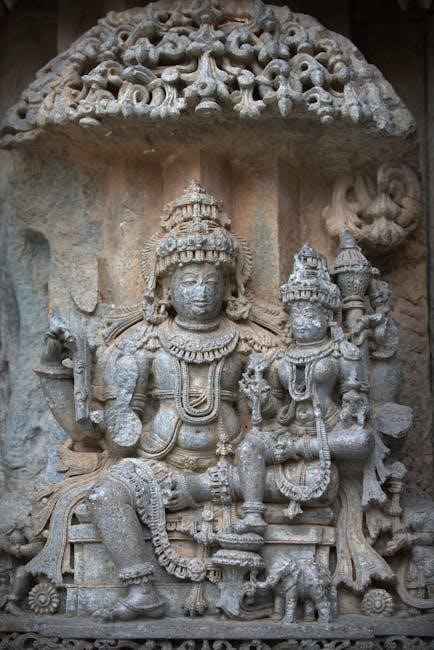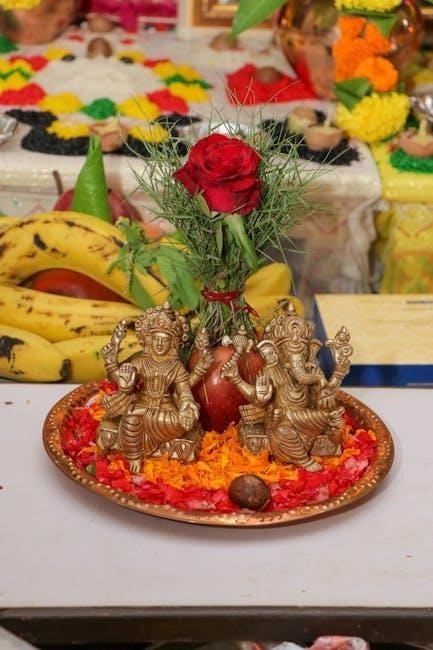The Lakshmi Sahasranamavali is a revered Hindu text containing 1008 divine names of Goddess Lakshmi, symbolizing her infinite qualities and blessings. It is a powerful tool for spiritual growth and material prosperity, often recited during rituals like Navaratri to invoke her divine grace and ensure well-being.
1.1 Overview of the Significance of Lakshmi Sahasranamavali
Lakshmi Sahasranamavali holds immense spiritual and cultural significance as a sacred Hindu text dedicated to Goddess Lakshmi, the embodiment of wealth, prosperity, and divine grace. This collection of 1008 names is revered for its ability to invoke blessings, ensure material abundance, and foster inner peace. Each name encapsulates a unique attribute of the goddess, reflecting her multifaceted nature and universal appeal. Reciting the Sahasranamavali is believed to purify the mind, attract positive energy, and strengthen one’s connection with the divine feminine. It is often chanted during auspicious occasions, rituals, and personal worship to seek Goddess Lakshmi’s grace. The text is also valued for its philosophical depth, offering insights into the nature of wealth, happiness, and spiritual growth. Its significance extends beyond mere recitation, serving as a powerful tool for self-refinement and spiritual elevation.
1.2 Purpose of the Lakshmi Sahasranamavali PDF
The Lakshmi Sahasranamavali PDF serves as a convenient and accessible resource for devotees to recite and study the sacred hymn. Its primary purpose is to provide a clear, structured, and portable format of the 1008 names of Goddess Lakshmi, making it easier for individuals to incorporate the recitation into their daily rituals or spiritual practices. The PDF acts as a guide, ensuring that devotees can accurately chant the names and reap their spiritual benefits. It is designed to assist in seeking Goddess Lakshmi’s blessings for prosperity, peace, and harmony. Additionally, the PDF format allows for easy sharing and preservation, making the ancient text accessible to a wider audience while maintaining its sacred integrity and cultural significance.

Origins and Historical Context
The Lakshmi Sahasranamavali originates from ancient Hindu scriptures, particularly the Skanda Purana, attributed to Sage Sanath Kumara and twelve sages, reflecting its deep spiritual and historical roots.
2.1 The Skanda Purana and Its Role in Lakshmi Sahasranamavali
The Lakshmi Sahasranamavali is deeply rooted in the Skanda Purana, one of the 18 Mahapuranas in Hindu scripture. This revered text is a primary source for the Sahasranamavali, containing the 1008 names of Goddess Lakshmi. The Skanda Purana is attributed to Sage Sanath Kumara and is considered a foundational text for understanding the divine attributes of Lakshmi. It emphasizes her role as the embodiment of prosperity, wisdom, and divine energy. The Sahasranamavali within the Skanda Purana is structured as a hymn, with each name reflecting a unique aspect of Lakshmi, making it a powerful tool for devotion and spiritual growth. Its inclusion in this ancient scripture underscores its authenticity and significance in Hindu religious practices.
2.2 Sage Sanath Kumara and the 12 Sages
Sage Sanath Kumara, a revered figure in Hindu scriptures, is credited with the composition of the Lakshmi Sahasranamavali. He is often depicted as a wise and enlightened being, known for his deep spiritual insight. According to tradition, Sanath Kumara, along with 12 other sages, played a pivotal role in compiling and preserving the sacred hymns dedicated to Goddess Lakshmi. These sages are believed to have meditated upon the divine attributes of Lakshmi, leading to the revelation of her 1008 names. Their collective efforts ensured the Sahasranamavali’s authenticity and spiritual potency, making it a cornerstone of devotion for centuries. The involvement of these sages underscores the text’s sacred origins and its enduring relevance in Hindu spirituality.

Structure and Content of the Document
The Lakshmi Sahasranamavali PDF is structured as a sacred hymn, comprising 1008 names of Goddess Lakshmi, each describing her divine attributes and virtues. The document is divided into sections, with each name written in Sanskrit, often followed by its English translation. The text is poetic, rhythmic, and rich in spiritual significance, making it easy to recite and meditate upon. The names are arranged to reflect Lakshmi’s role as the embodiment of wealth, prosperity, and divine grace. The PDF also includes introductory prayers and concluding mantras, enhancing its spiritual depth and making it a comprehensive guide for devotees seeking to connect with the goddess.
3.1 The 1008 Names of Goddess Lakshmi
The Lakshmi Sahasranamavali contains 1008 divine names of Goddess Lakshmi, each encapsulating her divine attributes, virtues, and roles. These names are arranged in a poetic and rhythmic structure, making them ideal for recitation and meditation. Each name highlights aspects of Lakshmi, such as her role as the giver of wealth, prosperity, knowledge, and spiritual enlightenment. The names also emphasize her compassion, grace, and protection. The number 1008 symbolizes completeness and perfection, reflecting her omnipresent and all-encompassing nature. The names are written in Sanskrit, often with English translations in the PDF, ensuring accessibility for devotees worldwide. This collection is revered for its spiritual depth, offering a profound connection to the goddess and her blessings.
3.2 Key Themes and Attributes Described in the Names
The names in the Lakshmi Sahasranamavali reflect key themes such as prosperity, spiritual growth, and divine feminine energy. Goddess Lakshmi is often described as the embodiment of grace, wisdom, and maternal nurturing. Many names emphasize her role as the bestower of wealth, both material and spiritual, highlighting her benevolence. Themes of protection, compassion, and cosmic order are also prominent. Attributes like her radiant beauty, eternal presence, and association with lotus symbolism are frequently mentioned. These names collectively portray Lakshmi as a multifaceted deity, representing both worldly and transcendental aspects of life. The interplay of these themes underscores her significance as a universal mother and a source of infinite blessings. The diversity of her attributes makes the Sahasranamavali a rich tapestry of devotion and philosophical insight.

Benefits of Reciting Lakshmi Sahasranamavali
Reciting Lakshmi Sahasranamavali brings spiritual enlightenment, material prosperity, and inner peace. It enhances fortune, fosters positive energy, and strengthens devotion to Goddess Lakshmi, ensuring overall well-being and harmony.
4.1 Spiritual and Material Prosperity
Reciting Lakshmi Sahasranamavali is believed to bring both spiritual and material prosperity. Spiritually, it fosters inner peace, divine connection, and emotional fulfillment. Materially, it is thought to attract wealth, success, and abundance. By chanting the 1008 names of Goddess Lakshmi, devotees seek to balance their spiritual growth with worldly achievements. The recitation is also said to cleanse the mind of negative thoughts, promote financial stability, and grant the devotee a sense of contentment. Many followers believe that this sacred text helps in overcoming financial difficulties and enhances their overall quality of life. Thus, Lakshmi Sahasranamavali serves as a powerful tool for achieving harmony between spiritual enlightenment and material well-being.
4.2 Emotional and Mental Well-being
Reciting Lakshmi Sahasranamavali is also known to enhance emotional and mental well-being. The rhythmic chanting of the 1008 names creates a calming effect on the mind, reducing stress and anxiety. It helps devotees cultivate a sense of inner peace and balance, fostering positive emotions like gratitude and joy. By focusing on the divine attributes of Goddess Lakshmi, individuals can gain clarity of thought and emotional resilience. The practice is believed to alleviate mental turmoil, promote self-confidence, and instill patience. Regular recitation can lead to a harmonious state of mind, enabling individuals to handle life’s challenges with equanimity. This spiritual practice not only uplifts the spirit but also nurtures mental health, making it a holistic approach to emotional well-being.
How to Recite Lakshmi Sahasranamavali
Begin by sitting comfortably with hands in Anjali mudra. Focus on a sacred object like a mala or Lakshmi idol. Ensure concentration and a pure heart. Keep the environment clean and quiet for uninterrupted recitation. Chant clearly, maintaining rhythm and devotion. Offer prayers before starting and express gratitude after completion. Regular practice enhances spiritual connection and effectiveness.
5.1 Best Time and Conditions for Recitation
The ideal time to recite Lakshmi Sahasranamavali is during the early morning hours, just after sunrise, or in the evening around sunset. These periods are considered auspicious for spiritual practices. Ensure a clean, quiet, and peaceful environment to maintain focus. Lighting a lamp or burning incense can create a sacred ambiance. It is recommended to sit facing east or north, as these directions are believed to enhance concentration. Avoid distractions and maintain a calm state of mind. Recitation during festivals like Navaratri or on Fridays is particularly beneficial, as these days are associated with Goddess Lakshmi. Consistency in timing and environment helps in deriving maximum spiritual benefits from the recitation.
5.2 Rituals and Preparations for Effective Chanting
To chants the Lakshmi Sahasranamavali effectively, certain rituals and preparations are essential; Begin by cleansing the space with incense or camphor and setting up a deity or image of Goddess Lakshmi. Offer flowers, fruits, or sweets as prasad. Bathe and wear clean, auspicious clothing, preferably in shades of red or yellow. Sit comfortably on an asana or a clean cloth, facing east or north. Light a lamp and recite the mantra “Om Shreem Mahalakshmiyei Namah” before starting. Use a rudraksha or tulsi mala for counting; Maintain a calm and focused mind, avoiding distractions. These preparations create a sacred atmosphere, enhancing the spiritual impact of the recitation and aligning the practitioner with divine energy. Consistency in these rituals is key to experiencing the full benefits of the Sahasranamavali.

Lakshmi Sahasranamavali in Different Languages
The Lakshmi Sahasranamavali is available in multiple languages, including Sanskrit, Telugu, Tamil, Kannada, and English, ensuring accessibility for devotees worldwide. These translations preserve the sacred essence and meaning of the original text, allowing followers from diverse linguistic backgrounds to connect with Goddess Lakshmi’s divine attributes and seek her blessings through recitation.
6.1 Sanskrit, Telugu, Tamil, and Kannada Versions
The Lakshmi Sahasranamavali is predominantly available in Sanskrit, the original language of composition, which is revered for its spiritual purity and phonetic precision. Regional languages like Telugu, Tamil, and Kannada have also embraced this sacred text, making it accessible to devotees across South India. These versions are meticulously translated to preserve the divine essence and meaning of the 1008 names of Goddess Lakshmi. The Sanskrit version, sourced from the Skanda Purana, is considered the most authentic and is often used in rituals and pujas. The Telugu, Tamil, and Kannada translations cater to the linguistic and cultural preferences of devotees in Andhra Pradesh, Tamil Nadu, and Karnataka, respectively. Each version maintains the spiritual significance and devotional appeal of the original text, ensuring its reach and impact across diverse communities.
6.2 English Translations for Global Accessibility
The Lakshmi Sahasranamavali is now widely available in English translations, catering to a global audience seeking spiritual enrichment. These translations aim to preserve the sacred essence of the original Sanskrit text while making it accessible to non-native speakers. The English versions are particularly beneficial for devotees who may not be fluent in Indian languages but wish to connect with the divine attributes of Goddess Lakshmi. Many reputable sources, including official spiritual websites and publishers, offer these translations, ensuring authenticity and clarity. The inclusion of transliterations alongside English translations further enhances the accessibility of the text, allowing devotees to recite the names even if they are unfamiliar with Sanskrit or regional scripts. This global outreach ensures the timeless wisdom of Lakshmi Sahasranamavali remains relevant in a modern, interconnected world.

Notable Sources for Lakshmi Sahasranamavali PDF
Reputable platforms like SanskritDocuments.org and trusted spiritual websites offer authentic Lakshmi Sahasranamavali PDFs, ensuring easy access for devotees worldwide.
7.1 SanskritDocuments.org as a Primary Source
SanskritDocuments.org is a highly respected repository for ancient Indian texts, offering an authentic Lakshmi Sahasranamavali PDF. This platform is renowned for its accuracy and purity in preserving sacred scriptures. The PDF available here is presented in its original Sanskrit form, accompanied by clear transliterations and meanings, making it accessible to both scholars and devotees. The document is meticulously formatted, ensuring ease of reading and recitation. As a trusted source, it adheres to traditional standards, making it a preferred choice for those seeking an authentic version. The PDF is free to download, and its digital format ensures widespread accessibility. For those seeking a reliable and genuine Lakshmi Sahasranamavali, SanskritDocuments.org remains an unparalleled resource.
7.2 Other Trusted Websites and Publishers
Besides SanskritDocuments.org, several other trusted platforms offer authentic Lakshmi Sahasranamavali PDFs. Websites like VedicSociety.org and TemplePurohit.com provide downloadable versions, ensuring accessibility for devotees worldwide. These sites often include translations and commentaries, enhancing understanding for modern readers. Additionally, renowned publishers such as Gita Press and Chinmaya Mission publish physical and digital copies of the text. These sources are known for their authenticity and adherence to traditional standards. For those seeking a verified version, these platforms are reliable alternatives. Their contributions ensure that the sacred text remains accessible and preserved for future generations. These trusted sources are widely recognized for their commitment to maintaining the integrity of ancient scriptures.

Cultural and Religious Significance
Lakshmi Sahasranamavali holds profound cultural and religious significance, revered for its divine chants and spiritual essence, deeply rooted in Hindu traditions and festivals like Navaratri and Diwali.
8.1 Role in Navaratri Puja and Lakshmi Jayanti
Lakshmi Sahasranamavali plays a pivotal role in Navaratri Puja, a nine-day festival honoring the divine feminine. It is chanted during the worship of Goddess Lakshmi, particularly on the third day of the festival, which is dedicated to her. The recitation is believed to invoke her blessings for prosperity, wealth, and wisdom. Additionally, it is an integral part of Lakshmi Jayanti, the birthday celebration of Goddess Lakshmi, where devotees chant the Sahasranamavali to seek her grace and fulfillment of desires. These sacred occasions highlight the spiritual and cultural significance of the text, making it a cornerstone of devotional practices during these festivities.
8.2 Connection to Ashtalakshmi and Other Forms of Lakshmi
The Lakshmi Sahasranamavali deeply connects with the concept of Ashtalakshmi, which represents eight distinct forms of Goddess Lakshmi, each symbolizing a different aspect of prosperity and well-being. These forms include Adi Lakshmi, Dhana Lakshmi, Dhanya Lakshmi, Gaja Lakshmi, Santana Lakshmi, Veera Lakshmi, Vijaya Lakshmi, and Vidya Lakshmi. The Sahasranamavali not only honors these eight forms but also extends to other divine manifestations of Lakshmi, such as Maha Lakshmi, who embodies supreme power and grace. By invoking these names, devotees seek blessings across various life aspects, from material wealth to spiritual enlightenment. This connection underscores the versatility and universal appeal of Lakshmi, making the Sahasranamavali a comprehensive tribute to her divine presence in all its forms.

Downloading the Lakshmi Sahasranamavali PDF
The Lakshmi Sahasranamavali PDF is easily accessible from various spiritual and religious websites. It is often available for free download, making it convenient for devotees worldwide.
Ensure to download from trusted sources to maintain authenticity and quality. The PDF format allows seamless access on devices, enabling effortless recitation and study.
Many platforms offer translations and commentaries, catering to diverse preferences. Downloading the PDF is a simple process, requiring minimal effort for spiritual seekers;
9.1 Steps to Access the PDF from Reliable Sources
To download the Lakshmi Sahasranamavali PDF, visit trusted websites like SanskritDocuments.org or other reputable sources. Use specific search terms like “Lakshmi Sahasranamavali PDF” or “Lakshmi Sahasranamavali in Sanskrit” to find authentic versions. Ensure the website is credible by checking for extensions like .org or .edu, which often host religious texts. Once on the site, navigate to the download section and click on the provided link. Some platforms may require creating a free account or verifying your email. After downloading, review the PDF to ensure it contains the full 1008 names without errors. Avoid unofficial or suspicious sites that may offer incomplete or corrupted files. Always prioritize sources with positive user reviews and testimonials for a safe and reliable experience.
9.2 Importance of Verifying Authenticity
Verifying the authenticity of the Lakshmi Sahasranamavali PDF is crucial to ensure its spiritual and religious efficacy. An authentic version guarantees that the 1008 names of Goddess Lakshmi are accurately presented, preserving their divine significance and potency; Inauthentic or misprinted versions may contain errors, omissions, or incorrect interpretations, which could undermine the spiritual benefits of recitation. Additionally, genuine sources like SanskritDocuments.org or reputable publishers adhere to traditional scripts and translations, maintaining the sanctity of the text. Before downloading, cross-referencing with trusted scholars or religious authorities can help confirm the document’s legitimacy. This step ensures that devotees receive a reliable and spiritually meaningful version of the Sahasranamavali.
- Authenticity ensures the correct recitation of divine names.
- Errors in the text can reduce spiritual benefits.
- Trustworthy sources maintain the text’s sanctity.

Practical Guidance for Beginners
Beginners should start by understanding the structure and significance of Lakshmi Sahasranamavali, focusing on slow recitation and correct pronunciation. Using a PDF guide can enhance clarity and devotion, ensuring meaningful practice.
10.1 Understanding the Basics of Sahasranamavali
The Lakshmi Sahasranamavali is a sacred hymn consisting of 1000 names of Goddess Lakshmi, compiled in Sanskrit. It is an integral part of the Skanda Purana and is revered for its ability to invoke divine blessings. The text is structured into sections, with each name describing a unique attribute or aspect of the goddess, emphasizing her role as the embodiment of wealth, prosperity, and spiritual growth. Understanding the basics involves recognizing the significance of each name, which often symbolizes virtues like compassion, wisdom, and generosity. For beginners, it is essential to grasp the meaning behind these names and how they collectively glorify Lakshmi. This foundational knowledge enhances the recitation experience, allowing devotees to connect deeply with the divine energy of the goddess.
10.2 Tips for Effective and Meaningful Recitation
To recite Lakshmi Sahasranamavali effectively, start by understanding the meaning of each name, as it deepens the connection with Goddess Lakshmi. Pronounce each name correctly, as inaccuracies may reduce the spiritual impact. Maintain focus and concentration during recitation, avoiding distractions. Create a peaceful environment, ideally sitting in a calm and clean space; Begin with a prayer to Goddess Lakshmi, seeking her blessings. Recite the names slowly and steadily, allowing the vibrations of the mantras to resonate within. For beginners, reciting a few names daily and gradually increasing the count can build consistency. Use the Lakshmi Sahasranamavali PDF for accuracy, as it provides the correct order and pronunciation. Group recitation can also amplify the energy and create a collective spiritual experience. Consistency and patience are key, as the benefits unfold over time with sincere practice.
Comments